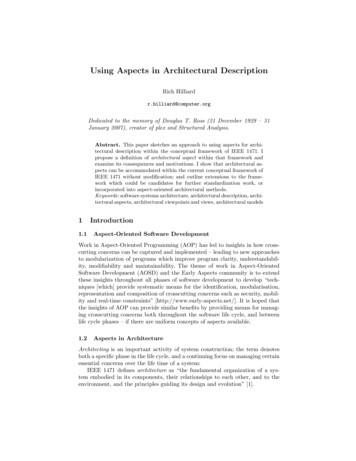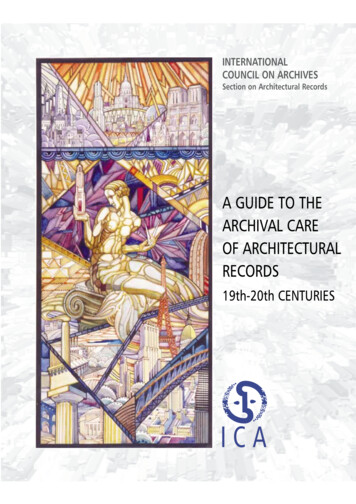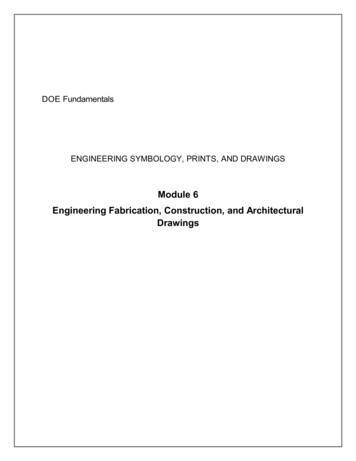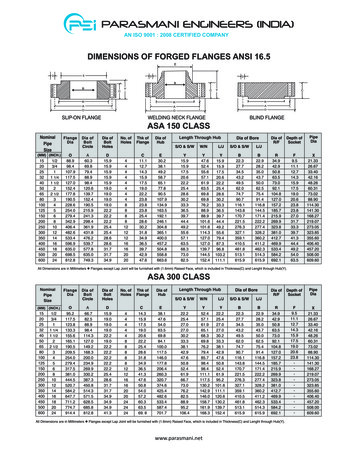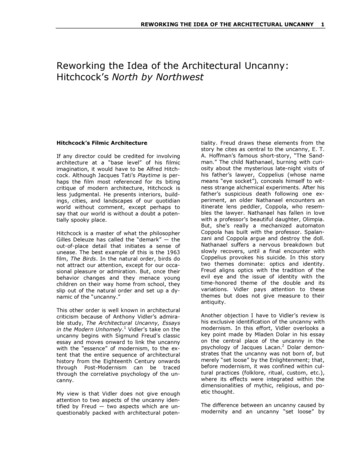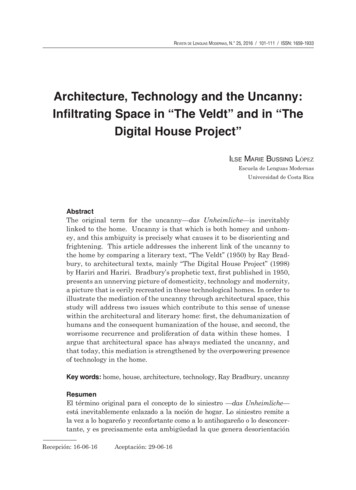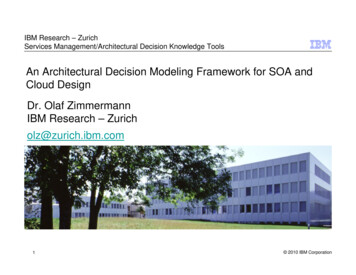
Transcription
AN ARCHITECTURAL DIMENSIONS BASEDSOFTWARE FUNCTIONAL SIZE MEASUREMENT METHODA THESIS SUBMITTED TOTHE GRADUATE SCHOOL OF INFORMATICSOFTHE MIDDLE EAST TECHNICAL UNIVERSITYBYÇİĞDEM GENCELIN PARTIAL FULFILLMENT OF THE REQUIREMENTS FOR THE DEGREE OFDOCTOR OF PHILOSOPHYINTHE DEPARTMENT OF INFORMATION SYSTEMSJULY 2005
PLAGIARISMI hereby declare that all information in this document has been obtained andpresented in accordance with academic rules and ethical conduct. I alsodeclare that, as required by these rules and conduct, I have fully cited andreferenced all material and results that are not original to this work.Name, Surname: Çiğdem GencelSignature:
Approval of the Graduate School of InformaticsAssoc.Prof.Dr. Nazife BAYKALDirectorI certify that this thesis satisfies all the requirements as a thesis for the degree of Doctorof Philosophy.Assoc.Prof.Dr. Onur DEMİRÖRSHead of DepartmentThis is to certify that we have read this thesis and that in our opinion it is fully adequate,in scope and quality, as a thesis for the degree of Doctor of Philosophy.Assoc.Prof.Dr. Onur DEMİRÖRSSupervisorExamining Committee MembersProf.Dr. Semih BİLGEN (METU, EEE)Assoc.Prof.Dr. Onur DEMİRÖRS (METU, IS)Assoc.Prof.Dr. Ali DOĞRU (METU, CENG)Assist.Prof.Dr. Kayhan İMRE (HU, CENG)Dr. Altan KOÇYİĞİT (METU, IS)
ABSTRACTAN ARCHITECTURAL DIMENSIONS BASEDSOFTWARE FUNCTIONAL SIZE MEASUREMENT METHODGencel, ÇiğdemPh.D., Department of Information SystemsSupervisor: Assoc.Prof.Dr. Onur DemirörsJuly 2005, 300 pagesThis thesis study aims to examine the conceptual and theoretical differences of FunctionalSize Measurement (FSM) methods, to identify the improvement opportunities of thesemethods and to develop a new FSM method. A comprehensive literature review isperformed and two multiple-case studies are conducted as a research strategy. In the lightof the results obtained, some improvement suggestions on two of the most challengingimprovement opportunities identified for FSM methods are made – improvementopportunities which are related to the conceptual and theoretical basis of FSM and theextension of the applicability of these methods to different software functional domaintypes. The work behind these suggestions involves the critical examination of the concepts“functionality” and “functional size” and the depiction of “types of functionality”considering the components of software architecture and the forms of informationprocessing logic performed in different software functional domain types. Based on thesuggestions made, a new FSM method, called ARCHItectural DIMensions Based FSM (ARCHIDIM) is developed conforming to the ISO/IEC 14143-1 standard. A third multiple-case studyis conducted in order to evaluate the new method and to identify future directions for FSMmethods.Keywords: Software size measurement, Functional size measurement, Functionalityiv
ÖZMİMARİ BOYUTLARA DAYANAN YENİ BİRYAZILIM FONKSİYONEL BÜYÜKLÜK ÖLÇME YÖNTEMİGencel, ÇiğdemDoktora, Bilişim Sistemleri BölümüTez Yöneticisi: Doç.Dr. Onur DemirörsTemmuz 2005, 300 sayfaBu çalışma Fonksiyonel Büyüklük Ölçme (FBÖ) yöntemlerinin kavramsal ve kuramsalfarkılıklarını araştırmayı, bu yöntemler için iyileştirme fırsatlarını belirlemeyi ve yeni birFBÖ yöntemi geliştirmeyi amaçlamaktadır. Kapsamlı bir literatür taraması yapılmış vearaştırma stratejisi olarak iki çok-örnekli olay incelemesi yürütülmüştür. Bulgular ışığında,FBÖ için belirlenmiş iyileştirme fırsatlarından önemli iki iyileştirme fırsatı olan FBÖyöntemlerinin kavramsal ve teorik bazlarının iyileştirilmesi ve uygulanabilirliklerinin farklıyazılım fonksiyonel alan türleri için genişletilmesi ile ilgili öneriler getirilmiştir. nın eleştirel olarak incelenmesini ve yazılım mimari ögeleri ile farklı yazılımfonksiyonel alan tiplerindeki bilgi işleme mantığı biçimlerini dikkate alarak “fonksiyonelliktipleri” nin belirlenmesini içermektedir. Getirilen öneriler baz alınarak ISO/IEC 14143-1standardına uyumlu Mimari Boyutlara Dayanan FBÖ (ARCHI-DIM) olarak adlandırılmış yenibir yöntem geliştirilmiştir. Bu yöntemi değerlendirmek ve gelecek araştırma doğrultularınıbelirlemek için üçüncü bir çoklu-örnek olay incelemesi yürütülmüştür.Anahtar kelimeler: Yazılım büyüklük ölçme, Fonkiyonel büyüklük ölçme, Fonksiyonellikv
DEDICATIONTo Hatice, Kemal and Özgür Gencelvi
ACKNOWLEDGMENTSI express my sincere appreciation to my supervisor Onur Demirörs, not only foraccepting me to study with him, but also for his guidance, his stimulating suggestions andinsightful comments throughout my research. I am grateful to him for his friendship, hisfaith in me and for letting me to study in a friendly and relaxing atmosphere.I also want to thank my committee members Semih Bilgen, Altan Koçyiğit, AliDoğru and Kayhan İmre for their valuable suggestions and comments. I am grateful to AltanKoçyiğit also for his physical and moral support, which helped me a lot during my hardtimes. His support, at a very critical time during my PhD study, is invaluable.The technical assistance, close collaboration and moral support of Erhan Yüceer isgratefully acknowledged. His friendship is one of the most valuable gains of this research. Ialso want to thank his wife Ahu and their little son Can for their infinite patience.I want to express my appreciation to Oktay Türetken for the valuable discussionswe made on this thesis study during the coffee breaks. His contribution to this research issignificant.Thanks go to Pınar Efe for her close collaboration and for providing me the data inconducting the case study part of this research.I wish to express my gratitude to Neşe Yalabık who continuously supported methroughout my PhD study.Many thanks to Ayça Tarhan, Onur Su, Meltem Sönmez and Burcu Akkan for theirvaluable suggestions and moral support.I want to thank Nil Korkut for her assistance in reviewing and proofreading some ofthe work related to this research and for offering me valuable suggestions.vii
Special thanks to Cihan Yıldırım, Seçil Canbaz Hüseyinoğlu, Umut Hüseyinoğlu andYasemin Salihoğlu. Their continous support and encouragement have been a source ofstrength. I will never forget the special gift of Umut Hüseyinoğlu - a poem of Cavafy which he thought that resembles my road of PhD.Heartfelt thanks to Cüneyt Sevgi for his continual encouragement, his tirelessassistance, helpful suggestions and critical comments. I am deeply indebted to him for hisenthusiasm for what I do and his endless physical and moral support through all the stagesof my PhD study.Finally, I would like to thank my family - my brother, my mom and my dad - forbeing there for me whenever I needed them, and for their love, understanding, patience,and unshakable faith in me. They are my inspiration to find the power in my heart fordoing what I want in my life*.My thanks and apologies to others whom I may have inadvertently forgotton tomention.*Son olarak aileme – kardeşime, anneme ve babama - ihtiyaç duyduğum her zaman yanımdaoldukları için ve sevgileri, anlayışları, sabırları ve bana olan sarsılmaz güvenleri için teşekkür etmekistiyorum. Onlar benim hayatta istediğim her şeyi yapabilmem için kalbimdeki gücü bulmamda ilhamkaynaklarım.viii
IthacaWhen you set out on your journey to Ithaca,pray that the road is long,full of adventure, full of knowledge.The Lestrygonians and the Cyclops,the angry Poseidon -- do not fear them:You will never find such as these on your path,if your thoughts remain lofty, if a fineemotion touches your spirit and your body.The Lestrygonians and the Cyclops,the fierce Poseidon you will never encounter,if you do not carry them within your soul,if your soul does not set them up before you.Pray that the road is long.That the summer mornings are many, when,with such pleasure, with such joyyou will enter ports seen for the first time;stop at Phoenician markets,and purchase fine merchandise,mother-of-pearl and coral, amber and ebony,and sensual perfumes of all kinds,as many sensual perfumes as you can;visit many Egyptian cities,to learn and learn from scholars.Always keep Ithaca in your mind.To arrive there is your ultimate goal.But do not hurry the voyage at all.It is better to let it last for many years;and to anchor at the island when you are old,rich with all you have gained on the way,not expecting that Ithaca will offer you riches.Ithaca has given you the beautiful voyage.Without her you would have never set out on the road.She has nothing more to give you.And if you find her poor, Ithaca has not deceived you.Wise as you have become, with so much experience,you must already have understood what Ithacas mean.Constantine P. Cavafy (1911)ix
TABLE OF CONTENTSPLAGIARISM . iiABSTRACT. ivÖZ. vDEDICATION. viACKNOWLEDGMENTS . viiTABLE OF CONTENTS . xLIST OF TABLES . xiiLIST OF FIGURES .xvLIST OF ACRONYMS / ABBREVIATIONS . xviCHAPTER . 11 INTRODUCTION . 11.1Scope of the Thesis Study . 31.2Research Strategy . 31.3Road Map . 42 RELATED RESEARCH . 62.1Software Size Metrics . 62.2Software Size Estimation / Measurement Methods . 82.2.1Derived Measurement / Estimation Methods . 92.2.2Classification of Software Size Measurement Methods.222.3The Differences between FSM Methods .272.4Discussion of the Literature Survey Results.36x
3 A NEW FSM METHOD: ARCHI-DIM FSM.403.1Overview.403.2The Need for a New Approach for Counting Software Functional Size.413.3ARCHI-DIM FSM Method and the Measurement Guidelines .483.3.1Introduction .483.3.2ARCHI-DIM Measurement Process - The Method and the Rules .524 CASE STUDIES ON FUNCTIONAL SIZE MEASUREMENT.654.1Research Methodology .654.2Case Studies on the Implementation of FSM Methods .694.2.1Case Study 1: Utilizing Size Estimation Methods Early in the Life Cycle .704.2.2Case Study 2: Implementation of FSM Methods to Different ApplicationDomains .844.2.3Case Study 3: Implementation of ARCHI-DIM FSM . 1075 CONCLUSIONS . 1315.1Contributions to the Field of Software Engineering . 1325.1.1Improvement Opportunities of FSM Methods . 1325.1.2Development of a New FSM Method: ARCHI-DIM FSM. 1495.2Suggestions for Future Research . 1516 BIBLIOGRAPHY . 153APPENDICES. 159A . 160B . 164C . 177VITA. 300xi
LIST OF TABLESTable 1 Software Size Measurement Methods Based on “Functionality” Metric .12Table 2 Parts of ISO/IEC 14143: Information Technology - Software Measurement Functional Size .13Table 3 Criteria for the Classification of Software Size Measurement Methods .22Table 4 BFC Types of Methods Based on “Functionality” Metrics.25Table 5 Main Differences between IFPUG FPA, Mk II FPA and COSMIC FFP Methods .32Table 6 Forms of Processing Logic Performed by BFC Types of FSM Methods.44Table 7 Characteristics by Field of Application .46Table 8 Forms of Processing Logic and Software Functionality Types .47Table 9 The Naming Convention used in Case Study 2 and Case Study 3 .70Table 10 Size Estimates of the Subsystems of the Case Project by Mk II FPA.74Table 11 Size Estimation of Module A1 by COSMIC FFP.76Table 12 Size Estimation of Module A1 by IFPUG FPA .76Table 13 Taxonomy for Defining Software Projects .77Table 14 Elements of the EFPA Method .78Table 15 EFPA Size Estimates for Consecutive Stages .79Table 16 Size Estimates by EFPA at Consecutive Stages and the Relative Errors with respectto Mk II FPA Estimate .81Table 17 Efforts Utilized for the Life Cycle Processes of Project-1 .87Table 18 Case Study 2.1 Mk II FPA Size Measurement Details .88Table 19 Case Study 2.1 COSMIC FFP Size Measurement Details.88Table 20 The Productivity Rates (Code & Unit Test Effort / Functional Size) of theSubsystems of Case Study 2.1 .89Table 21 The Productivity Rates (Development Effort/Functional Size) of Case Study2.1.89Table 22 The Productivity Rates (Code & Unit Test Effort / SLOC) of Case Study 2.1.89Table 23 The Productivity (Development Effort / SLOC) Values of Case Study 2.1 .90Table 24 The Ratio of Functional Size (Mk II FP & Cfsu) to SLOC Values of Case Study2.1.90Table 25 Efforts Utilized for the Life Cycle Processes of Case Study 2.2.92Table 26 Case Study 2.2 Mk II FPA Size Measurement Details .93Table 27 Case Study 2.2 COSMIC FFP Size Measurement Details .93xii
Table 28 The Productivity Rates (Code & Unit Test Effort/Funct. Size) of Case Study 2.2 .94Table 29 The Productivity Rates (Development Effort/Functional Size) of Case Study2.2.94Table 30 The Productivity (Code & Unit Test Effort / SLOC) Values of Case Study 2.2 .94Table 31 The Productivity (Development Effort / SLOC) Values of Case Study 2.2 .95Table 32 The Ratio of Functional Size (Mk II FP & Cfsu) to SLOC Values of Case Study2.2.95Table 33 Efforts Utilized for the Life Cycle Processes of Case Study 2.3.96Table 34 Case Study 2.3 Mk II FPA Size Measurement Details .97Table 35 Case Study 2.3 COSMIC FFP Size Measurement Details .98Table 36 The Productivity (Code & Unit Test Effort / Functional Size) Rates of Project-3 .98Table 37 The Productivity (Effort / Functional Size) Values of Case Study 2.3.98Table 38 SLOC Values of Case Study 2.3 .99Table 39 Case Study-2 Mk II FPA Size Measurement Details . 100Table 40 Case Study-2 COSMIC FFP Size Measurement Details . 101Table 41 The Efforts Utilized for Functional Size Measurement in Case Study 2 . 107Table 42 Case Study 3.1 ARCHI-DIM FSM Size Measurement Details . 109Table 43 SLOC Values of Project-1 . 111Table 44 Case Study 3.2 ARCHI-DIM FSM Size Measurement Details . 113Table 45 SLOC Values of Project-3 . 114Table 46 The Code and Unit Test Effort Values of Project-3 . 114Table 47 Case Study 3.3 ARCHI-DIM FSM Size Measurement Details . 115Table 48 The Productivity (Code & Unit Test Effort / Functional Size) Rates of Project-3116Table 49 Mapping BFC Types of Mk II FPA and COSMIC FFP to the Constituent Parts ofARCHI-DIM FSM BFCs . 118Table 50 Summary of the Base Counts obtained by Mk II FPA, COSMIC FFP and ARCHI-DIMFSM . 119Table 51 The Functional Sizes (Mk II FP, Cfsu and ADfsu) and SLOC Values of theSubsystems of Project-1. 122Table 52 The Ratios of the Functional Sizes and SLOC Values of the Subsystems of Project-1. 123Table 53 The Ratio of SLOC to Functional Size of the Subsystems of Project-1 . 124Table 54 The Functional Sizes of the Subsystems of Project-1 Obtained by Mk II FPA,COSMIC FFP with respect to ARCHI-DIM FSM Dimensions . 125Table 55 The Ratios of SLOC to Functional Size (Mk II FP and Cfsu) of the Subsystems ofProject-1 . 126xiii
Table 56 Efforts Utilized for Functional Size Measurement by MkII FPA, COSMIC FFP andARCHI-DIM FSM. 129Table 57 The Correlation between Functional Size and Effort . 143Table 58 The Ratio of SLOC to Functional Size (Cfsu) . 144Table 59 The Ratio of SLOC (SmallTalk) to Functional Size (IFPUG FP). 145Table 60 The Ratio of SLOC (C ) to Functional Size (IFPUG FP) . 146Table 61 The Ratio of SLOC (Cobol) to Functional Size (IFPUG FP). 147Table 62 The Ratio of SLOC (C) to Functional Size (IFPUG FP). 148xiv
LIST OF FIGURESFigure 1 FSM Process of IFPUG FPA, Mk II FPA and COSMIC FFP.29Figure 2. ARCHI-DIM Measurement Process .50Figure 3. ARCHI-DIM Software Model.57Figure 4 Case Study Method .68Figure 5 Requirements Analysis Life Cycle .72xv
LIST OF ACRONYMS / ABBREVIATIONS3-DADfsuARCHI-DIM FSMASSET- SMFURGLGUIHTMLIICASEIDEFIFPUGIIU: Three-Dimensional: ARCHI-DIM FSM functional size unit: Architectural Dimensions Based FSM Method: Analytical Software Size Estimation Technique – Real-Time: Base Functional Component: Business Process Modeling: Collision Avoidance Subsystem: Cosmic Functional Size Unit: Commented Lines of Code: Constructive Cost Model: Component Object Points: Common Software Measurement International Consortium: Commercial Off-The Shelf: Data Element Type: Data Function: Data Flow Diagram: Delivered Source Instructions: Entry: Early and Quick: Extended Event Driven Process Chain: Early Function Points: Early Function Point Analysis: External Input: External Interface File: External Output: Elementary Process: External Inquiry: Entity - Relationship: Executable Statements: Functions: Fonksiyonel Büyüklük Ölçme: Full Function Points: The Finnish Software Metrics Association: Functional Primitive: Function Point: Function Point Analysis: Functional Size Measurement: Functional User Requirement: Granularity Level: Graphical User Interface: Hyper Text Markup Language: Input: Integrated Computer Aided Software Engineering: Integrated Computer Aided Manufacturing (I-CAM) Definition: International Function Point Users Group: Instance Interaction Unitxvi
ILFISBSGISOLDLOCLTmMDIUMFmFMISMK II AWUKSMAUMLUUCPUUCWVAFWXXML: Internal Logical File: International Software Benchmarking Standards Group: International Standards Organization: Logical Data Group: Lines of Code: Logical Transaction: meter: Master Detail Interaction Unit: Macrofunction: Microfunction: Management Information System: Mark II Function Point Analysis: Non-Commented Lines of Code: The Netherlands Function Point Users Group: The Netherlands Software Metrics Users Association: Average Number of Children per Base Class: Output: Object Oriented: Object Oriented Method Function Points: Object Oriented Function Points: Object Points: Processing Entity: Population Interaction Unit: Predictive Object Points: Read: Resolution Advisory: Record Element Type: Request for Proposal: Software Engineering Laboratory in Applied Metrics: Standard Generalized Markup Language: Source Lines of Code: Statistical Object Model: Software Productivity Research: Software Requirements Specification: Software Sizing Model: Standard Deviation: Software Capability Maturity Model: Traffic Collision Avoidance Subsystem: Transactional Function: Unadjusted Actor Weight: United Kingdom Software Metrics Association: Unified Modeling Language: Unadjusted Use Case Points: Unadjusted Use Case Weights: Value Adjustment Factor: Write: Exit: Extensible Markup Languagexvii
CHAPTERCHAPTER I1 INTRODUCTIONSoftware Engineering requires measuring the attributes of software to be able todescribe, prescribe, and predict. Tom De Marco states, “If you can’t measure it, you can’tmanage it”. That is, we need to estimate how much software to build, just as we need todetermine the weight and volume of an engineering product as part of the planningprocess.Estimation errors are essential cause of poor management which usually results inrunaway projects that spiral out of control (Glass, 2002). Whatever these projects produceis frequently behind schedule and over budget, and most often they fail to produce anyproduct at all. According to the Standish Group CHAOS report of 2003:-5% of software projects are terminated before they produce anything,-66% are considered to have failed,-Of those that do complete the average cost blowout is 43%,-The lost dollar value for USA projects in 2002 is estimated at US 38 billion withanother US 17 billion in cost overruns.The question of what causes runaway projects arises frequently in the softwareengineering field. One of the major causes of runaway projects is considered to beimmature measurement / estimation.All prior software effort and cost estimation research is based on the suppositionthat size is a primary predictor. One of the significant challenges of software engineeringremains to be reliable sizing of software. By estimating software size, it is possible toestimate development effort, which enables to estimate cost. Therefore, the primarymetric that must be identified is the one that infers size attribute.1
Various approaches to software size estimation are developed and applied indifferent phases of the development life cycle during the last 3 decades. The size ofsoftware can be estimated by classifying different types of externally observable features,and then by counting the occurrences of those features. Examples for these features maybe inputs and outputs from a software component. Each estimation method countsdifferent types of features in a different way. There might also be differences in themethods due to different application domains (MIS, real-time, control, etc.) which havedifferent features that should be considered.Among the various size estimation methods, the ones based on “functionality” arewidely-used due to their earlier applicability during the software life cycle. After thedescription of the original method based on “functionality to be delivered to the users” byAlbrecht (1979), variations of these methods have been developed. During the 1980s and1990s, several authors have suggested new Function Point counting techniques thatintended to improve the original Function Point Analysis (FPA) or extend its field ofapplication from business application software to real-time and algorithmic software(Symons, 2001).In 1996, the International Standards Organization (ISO) started a working group(ISO/IEC JTC1 SC7 WG12) to establish common principles of the methods based on“functionality”. They first published the first part of this standard (ISO/IEC 14143-1,1998), which defines the fundamental concepts of Functional Size Measurement (FSM) suchas “Functional Size”, “Base Functional Components (BFC)”, “BFC Types”, the FSM methodcharacteristics and requirements that should be met by a candidate method to beconformant to this standard. The standard promoted the consistent interpretation of FSMprinciples. After that, IEEE Std. 14143.1 (2000), which is an adoption of ISO/IEC 141431:1998, was published.Four more parts of ISO/IEC 14143, which are ISO/IEC 14143-2 (2002) - Conformityevaluation of software size measurement methods to ISO/IEC 14143-1:1998; ISO/IEC TR14143-3 (2003) - Verification of FSM methods; ISO/IEC TR 14143-4 (2002) - FSM Referencemodel and ISO/IEC TR 14143-5 (2004) - Determination of functional domains for use withFSM, were published in the following years.Being conformant to ISO/IEC 14143-1 (1998), detailed descriptions of four FSMmethods which are IFPUG Function Point Analysis (ISO/IEC 20926, 2003), Mark II FunctionPoint Analysis (ISO/IEC 20968, 2002), COSMIC Full Function Points (ISO/IEC 19761, 2003)2
and NESMA Function Point Analysis (ISO/IEC 24570, 2003) have been recently published asISO standards.Although it has gone a long way, FSM is still considered as “immature” andcriticized because of the general difficulty of the measurement process and theimmaturity of the measurement science for software engineering (Hughes, 2000; Fenton,1994; Fenton, 1996). The results of the literature review showed that there still existsignificant improvement opportunities for the existing FSM methods related to theirconceptual and theoretical basis, convertibility of functional sizes obtained by differentmethods, estimation early in the life cycle, suitability of methods for different applicationdomains, and validation and rigor which are available in other engineering disciplines.1.1Scope of the Thesis StudyThis thesis study aims to explore the improvement opportunities of FSM methodsand based on the findings, suggest some improvements and develop a new FSM method bymaking improvements on two of the most challenging improvement opportunities, whichare on the conceptual and theoretical basis of FSM and extension of the applicationdomain suitability.The research objectives of this thesis study are:-to examine the conceptual and theoretical differences between FSM methods,-to explore the applicability of FSM methods to measure the size of the projectsof different functional domain types,-to explore the applicability of size estimation methods at different phases ofthe software development life cycle,1.2-to bring into light the improvement opportunities related to FSM methods,-to make some improvement suggestions and-to develop a new FSM method based on the improvement suggestions.Research StrategyIn order to assist to meet the research objectives of this thesis study, weperformed empirical studies on FSM methods. There are several ways of doing empiricalresearch in software engineering, which may include formal experiments, surveys and case3
studies. We used case study as a research strategy in this thesis study, as we have nocontrol over behavioral events and we are examining contemporary events.Three case studies are conducted as part of this thesis study. The first case studyis a single-case study which was conducted to explore the applicability of four estimationmethods at different phases of the software development life cycle.The second case study is a multiple-case study which involves three differentcases. In this multiple case study, our objective is to explore the applicability of FSMmethods to measure the size of the projects of different functional domain types, examinethe
July 2005, 300 pages This thesis study aims to examine the conceptual and theoretical differences of Functional Size Measurement (FSM) methods, to identify the improvement opportunities of these methods and to develop a new FSM method. A comprehensive literature review is performed and two multiple-case studies are conducted as a research strategy.
